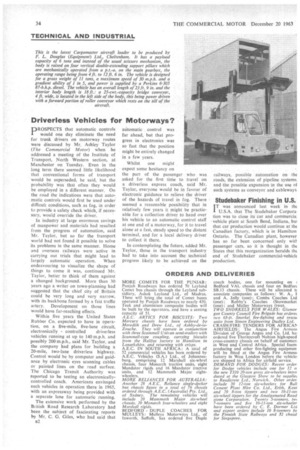Driverless Vehicles for Motorways?
Page 36

If you've noticed an error in this article please click here to report it so we can fix it.
PROSPECTS that automatic controls I would one day eliminate the need for trunk drivers on motorway routes were discussed by Mr. Ashley Taylor (The Commercial Motor) when he addressed a meeting of the Institute of Transport, North Western section, at Manchester on Tuesday. Even in the long term there seemed little likelihood that conventional forms of transport would be superseded, he said, but the probability was that often they would be employed in a different manner. On the road the indications were that automatic controls would first be used under difficult conditions, such as fog, in order to provide a safety check which, if necessary, would override the driver.
In industry at large enormous savings of manpower and materials had resulted from the progress of automation, said Mr. Taylor, but so far the transport world had not found it possible to solve its problems in the same manner. Home and overseas railways were active in carrying out trials that might lead to largely automatic operation. When endeavouring to visualize the shape of things to come it was, continued Mr. Taylor, better to think of them against a changed background. More than 30 years ago a writer on town-planning had suggested that the chief city of Britain could be very long and very narrow, with its backbone formed by a fist traffic artery. Development on those lines would have far-reaching effects.
Within five years the United States Rubber Co. expected to have in operation, on a five-mile, five-lane circuit, electronically controlled driverless vehicles running at up to 140 m.p.h. and possibly 200 m.p.h., said Mr. Taylor, and the company had plans for building a 20-mile, two-lane driverless highway. Control would be by computer and guidance by electronic eyes scanning cables or painted lines on the road surface. The Chicago Transit Authority was reported to be testing an electronicallycontrolled coach. Americans envisaged such vehicles in operation there in 1965, with an expressway being provided with a separate lane for automatic running.
The extensive work performed by the British Road Research Laboratory had been the subject of fascinating reports by Mr. C. G. Giles, who had said that B2 automatic control was far ahead, but that pro gress in electronics was so fast that the position might be entirely changed in a few years.
Whilst one might expect some hesitancy on the part of the passenger who was asked for the first time to travel on a driverless express coach, said Mr. Taylor, everyone would be in favour of electronic guidance to relieve the driver of the hazards of travel in fog. There seemed a reasonable possibility that in relatively few years it might be practicable for a collection driver to hand over his vehicle to an automatic control staff at one end of a motorway, for it to travel alone at a fast, steady speed to the distant terminal, and for a local delivery driver to collect it there.
In contemplating the future, added Mr. Taylor, those in the transport industry had to take into account the technical progress likely to be achieved on the railways, possible automation on the roads, the extension of pipeline systems and the possible expansion in the use ol such systems as conveyor arid cableways.
Studebaker Finishing in U.S. IT was announced last week in the .1 U.S.A. that The Studebaker Corpora. tion was to close its car and commercia vehicle plant at South Bend, Indiana, bui that car production would continue at the Canadian factory, which is in Hamilton Ontario. The Canadian plant, however has so far been concerned only witt passenger cars, so it is thought in the States that this reorganization heralds the end of Studebaker commercial-vehicle production.




























































































